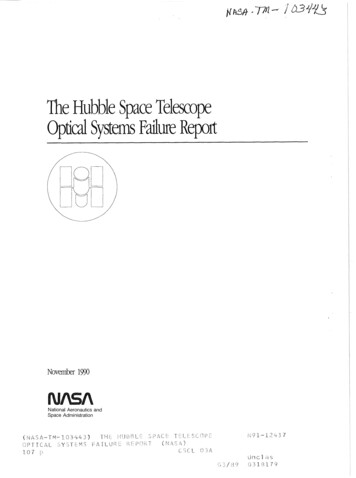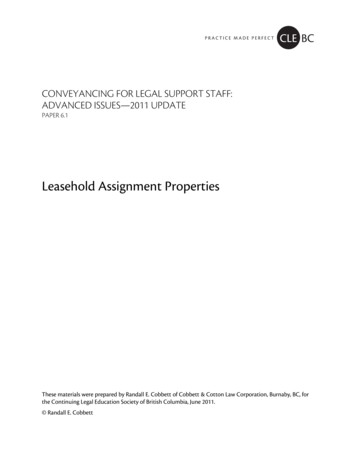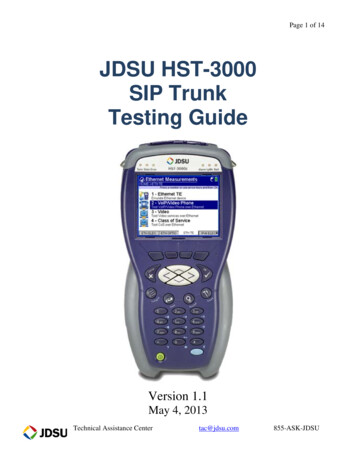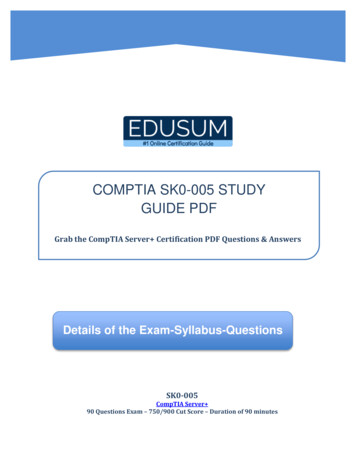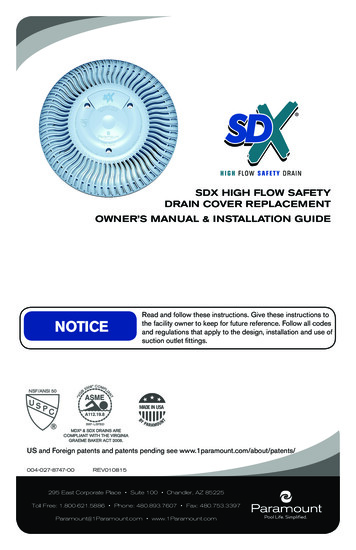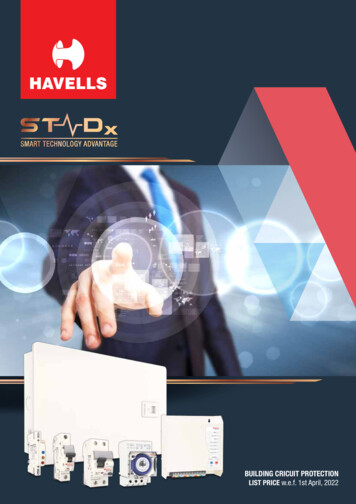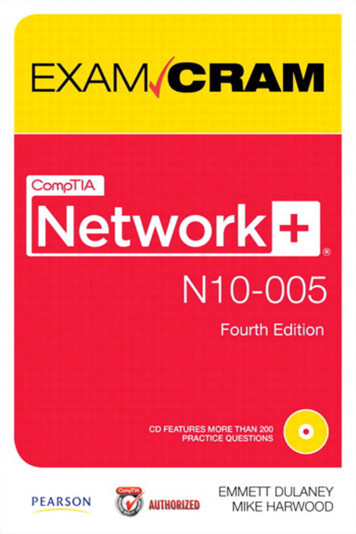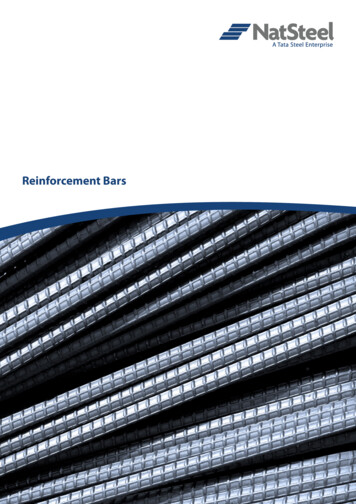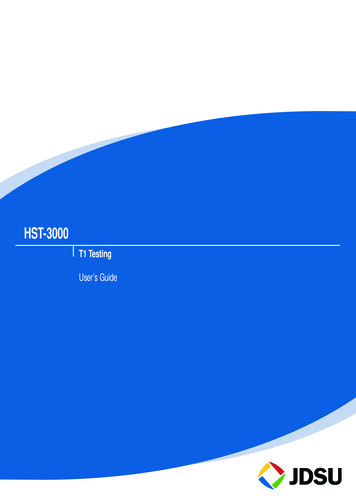
Transcription
HST-3000T1 TestingUser’s Guide
HST-3000T1 TestingUser’s GuideCommunications Test and Measurement SolutionsOne Milestone Center CourtGermantown, Maryland 20876-7100 USAToll Free 1-855-ASK-JDSU (1-855-275-5378)Tel 1-240-404-2999Fax 1-240-404-2195www.jdsu.com
Notice Every effort was made to ensure that the information in thisdocument was accurate at the time of printing. However, information is subject to change without notice, and JDSUreserves the right to provide an addendum to this documentwith information not available at the time that this documentwas created.Copyright Copyright 2012 JDS Uniphase Corporation. All rightsreserved. JDSU, Communications Test and MeasurementSolutions, and the JDSU logo are trademarks ofJDS Uniphase Corporation (“JDS Uniphase”). All other trademarks and registered trademarks are the property of theirrespective owners. No part of this guide may be reproducedor transmitted electronically or otherwise without written permission of the publisher.Copyright release Reproduction and distribution of this guide is authorized forGovernment purposes only.Trademarks JDS Uniphase, JDSU, HST-3000, and HST-3000C are trademarks or registered trademarks of JDS Uniphase Corporationin the United States and/or other countries.Microsoft, Windows, Windows NT, Excel, HyperTerminal, andInternet Explorer are either trademarks or registered trademarks of Microsoft Corporation in the United States and/orother countries.Westell is a trademark or registered trademark of WestellTechnologies, Inc.XEL is a trademark or registered trademark of XEL Communications, Inc.Specifications, terms, and conditions are subject to changewithout notice. All trademarks and registered trademarks arethe property of their respective companies.iiHST-3000 T1 Testing User’s Guide
Terms and Specifications, terms, and conditions are subject to changeconditions without notice. For current terms and conditions, go towww.jdsu.com/terms.Ordering This guide is a product of JDSU's Technical Informationinformation Development Department, issued as part of the HST-3000.The catalog number for a printed user’s guide is ML-058501.The catalog number for a USB stick containing the manual inelectronic form is ML-060301.FederalCommunicationsCommission (FCC)NoticeThis equipment has been tested and found to comply with thelimits for a Class B digital device, pursuant to Part 15 of theFCC Rules. These limits are designed to provide reasonableprotection against harmful interference in a residential installation. This equipment generates, uses and can radiate radiofrequency energy and, if not installed and used in accordancewith the instructions, may cause harmful interference to radiocommunications. However, there is no guarantee that interference will not occur in a particular installation.This device complies with Part 15 of the FCC Rules. Operation is subject to the following two conditions: (1) This devicemay not cause harmful interference, and (2) This device mustaccept any interference received, including interference thatmay cause undesired operation.If this equipment does cause harmful interference to radio ortelevision reception, which can be determined by turning theequipment off and on, the user is encouraged to try to correctthe interference by one or more of the following measures:– Reorient or relocate the receiving antenna.– Increase the separation between the equipment andreceiver.– Connect the equipment into an outlet on a circuit differentfrom that to which the receiver is connected.– Consult the dealer or an experienced radio/TV technicianfor help.HST-3000 T1 Testing User’s Guideiii
In order to maintain compliance with the limits of a Class Bdigital device JDSU requires that quality interface cables beused when connecting to this equipment. Any changes ormodifications not expressly approved by JDSU could void theuser's authority to operate the equipment.Industry Canada This Class B digital apparatus complies with CanadianRequirements ICES-003.Cet appareil numérique de la classe B est conforme à lanorme NMB-003 du Canada.WEEE and Battery JDSU has established processes in compliance with theDirective Waste Electrical and Electronic Equipment (WEEE) Directive,Compliance 2002/96/EC, and the Battery Directive, 2006/66/EC.This product, and the batteries used to power the product,should not be disposed of as unsorted municipal waste andshould be collected separately and disposed of according toyour national regulations. In the European Union, all equipment and batteries purchased from JDSU after 2005-08-13can be returned for disposal at the end of its useful life. JDSUwill ensure that all waste equipment and batteries returned arereused, recycled, or disposed of in an environmentally friendlymanner, and in compliance with all applicable national andinternational waste legislation.It is the responsibility of the equipment owner to return equipment and batteries to JDSU for appropriate disposal. If theequipment or battery was imported by a reseller whose nameor logo is marked on the equipment or battery, then the ownershould return the equipment or battery directly to the reseller.Instructions for returning waste equipment and batteries toJDSU can be found in the Environmental section of JDSU’sweb site at www.jdsu.com. If you have questions concerningdisposal of your equipment or batteries, contact JDSU’sWEEE Program Management team atWEEE.EMEA@jdsu.com.HST-3000 T1 Testing User’s Guideiv
ContentsAbout This GuidexiiiPurpose and scope . . . . . . . . . . . . . . . . . . . . . . . . . . . . . xivAssumptions . . . . . . . . . . . . . . . . . . . . . . . . . . . . . . . . . . xivTerminology . . . . . . . . . . . . . . . . . . . . . . . . . . . . . . . . . . . xivHST-3000 T1 testing user’s guide . . . . . . . . . . . . . . . . . .xvHST-3000 base unit user’s guide . . . . . . . . . . . . . . . . . . .xvSafety and compliance information. . . . . . . . . . . . . . . . xviTechnical assistance . . . . . . . . . . . . . . . . . . . . . . . . . . . . xviConventions. . . . . . . . . . . . . . . . . . . . . . . . . . . . . . . . . . . xviiChapter 1Getting started1Overview and options . . . . . . . . . . . . . . . . . . . . . . . . . . . . 2What’s new . . . . . . . . . . . . . . . . . . . . . . . . . . . . . . . . . . . . . 4T1 connectors . . . . . . . . . . . . . . . . . . . . . . . . . . . . . . . . . . 4Configuring your test . . . . . . . . . . . . . . . . . . . . . . . . . . . . 6Launching an application . . . . . . . . . . . . . . . . . . . . . . . 6Specifying basic test settings . . . . . . . . . . . . . . . . . . . . 9Saving test configurations . . . . . . . . . . . . . . . . . . . . . . 10Loading a configuration. . . . . . . . . . . . . . . . . . . . . . . . .11HST-3000 T1 Testing User’s Guidev
ContentsOverwriting a configuration . . . . . . . . . . . . . . . . . . . . . 11Deleting a configuration . . . . . . . . . . . . . . . . . . . . . . . . 12Restarting tests. . . . . . . . . . . . . . . . . . . . . . . . . . . . . . . . . 12Viewing test results . . . . . . . . . . . . . . . . . . . . . . . . . . . . . 12Clearing history results . . . . . . . . . . . . . . . . . . . . . . . . . . 13Instrument settings and user preferences . . . . . . . . . . . 13Chapter 2T1 and FT1 testing15About testing. . . . . . . . . . . . . . . . . . . . . . . . . . . . . . . . . . . 16Test modes . . . . . . . . . . . . . . . . . . . . . . . . . . . . . . . . . . . . 17Status LEDs. . . . . . . . . . . . . . . . . . . . . . . . . . . . . . . . . . . . 18Monitoring a channel . . . . . . . . . . . . . . . . . . . . . . . . . . . . 19Measuring timing slips. . . . . . . . . . . . . . . . . . . . . . . . . . . 29Terminate testing . . . . . . . . . . . . . . . . . . . . . . . . . . . . . . . 31Configuring user-defined loop codes. . . . . . . . . . . . . . . 45Pulse shape analysis . . . . . . . . . . . . . . . . . . . . . . . . . . . . 47Drop and insert testing . . . . . . . . . . . . . . . . . . . . . . . . . . 51Viewing test results . . . . . . . . . . . . . . . . . . . . . . . . . . . . . 61Troubleshooting . . . . . . . . . . . . . . . . . . . . . . . . . . . . . . . . 62Chapter 3T1 DDS testing65About testing. . . . . . . . . . . . . . . . . . . . . . . . . . . . . . . . . . . 66Test modes . . . . . . . . . . . . . . . . . . . . . . . . . . . . . . . . . . . . 66Status LEDs. . . . . . . . . . . . . . . . . . . . . . . . . . . . . . . . . . . . 67Monitoring a DDS channel . . . . . . . . . . . . . . . . . . . . . . . . 69Terminate testing . . . . . . . . . . . . . . . . . . . . . . . . . . . . . . . 77Viewing test results . . . . . . . . . . . . . . . . . . . . . . . . . . . . . 90Troubleshooting . . . . . . . . . . . . . . . . . . . . . . . . . . . . . . . . 91Chapter 4Voice Frequency (PCM) Analysis93About VF analysis. . . . . . . . . . . . . . . . . . . . . . . . . . . . . . . 94Operating modes . . . . . . . . . . . . . . . . . . . . . . . . . . . . . . . 95Status LEDs. . . . . . . . . . . . . . . . . . . . . . . . . . . . . . . . . . . . 95viHST-3000 T1 Testing User’s Guide
ContentsVF test options. . . . . . . . . . . . . . . . . . . . . . . . . . . . . . . . . 96Quiet tone test. . . . . . . . . . . . . . . . . . . . . . . . . . . . . . . 97Holding tone test . . . . . . . . . . . . . . . . . . . . . . . . . . . . . 97Three tone test . . . . . . . . . . . . . . . . . . . . . . . . . . . . . . 97Single tone test . . . . . . . . . . . . . . . . . . . . . . . . . . . . . . 97Frequency sweep test . . . . . . . . . . . . . . . . . . . . . . . . . 97Impulse noise test . . . . . . . . . . . . . . . . . . . . . . . . . . . . 98User-defined signaling bits . . . . . . . . . . . . . . . . . . . . . 98Performing VF analysis. . . . . . . . . . . . . . . . . . . . . . . . . . 98Viewing test results . . . . . . . . . . . . . . . . . . . . . . . . . . . . 107Troubleshooting . . . . . . . . . . . . . . . . . . . . . . . . . . . . . . 108Chapter 5PCM Signaling Analysis109About PCM signaling analysis . . . . . . . . . . . . . . . . . . . .110Test modes . . . . . . . . . . . . . . . . . . . . . . . . . . . . . . . . . . . .111Status LEDs . . . . . . . . . . . . . . . . . . . . . . . . . . . . . . . . . . .113Trunk type signaling . . . . . . . . . . . . . . . . . . . . . . . . . . . .114Standard E & M signaling . . . . . . . . . . . . . . . . . . . . . .115Loop start signaling . . . . . . . . . . . . . . . . . . . . . . . . . . .115Ground start signaling . . . . . . . . . . . . . . . . . . . . . . . . .117Monitoring a call . . . . . . . . . . . . . . . . . . . . . . . . . . . . . . 120Placing or receiving calls . . . . . . . . . . . . . . . . . . . . . . . 127Viewing test results . . . . . . . . . . . . . . . . . . . . . . . . . . . . 133Saving signaling events . . . . . . . . . . . . . . . . . . . . . . . . 134Saving test results. . . . . . . . . . . . . . . . . . . . . . . . . . . . . 135Chapter 6ISDN PRI testing137About ISDN PRI testing. . . . . . . . . . . . . . . . . . . . . . . . .Features and capabilities . . . . . . . . . . . . . . . . . . . . .Status LEDs . . . . . . . . . . . . . . . . . . . . . . . . . . . . . . . . . .Operating Modes . . . . . . . . . . . . . . . . . . . . . . . . . . . . . .Headset connector . . . . . . . . . . . . . . . . . . . . . . . . . . . .Using the Restart soft key . . . . . . . . . . . . . . . . . . . . . .Setting up the phone book . . . . . . . . . . . . . . . . . . . . . .Placing calls on the primary T1 . . . . . . . . . . . . . . . . . .138138140141142142143144HST-3000 T1 Testing User’s Guidevii
ContentsUsing the HST in Multiple Call mode . . . . . . . . . . . . . . 158Disconnecting a call . . . . . . . . . . . . . . . . . . . . . . . . . . . . 159Transmitting DTMF tones. . . . . . . . . . . . . . . . . . . . . . . . 160Placing calls on the secondary T1 . . . . . . . . . . . . . . . . 160Receiving a call. . . . . . . . . . . . . . . . . . . . . . . . . . . . . . . . 168Accepting a call . . . . . . . . . . . . . . . . . . . . . . . . . . . . . 168Rejecting a call. . . . . . . . . . . . . . . . . . . . . . . . . . . . . . 169Ignoring a call. . . . . . . . . . . . . . . . . . . . . . . . . . . . . . . 169Inserting voice traffic into a call . . . . . . . . . . . . . . . . . . 169Performing BER analysis of a call . . . . . . . . . . . . . . . . 171Transferring the B Channel for connected calls . . . . . 175Verifying the switch to a backup D Channel . . . . . . . . 175Monitoring ISDN PRI service . . . . . . . . . . . . . . . . . . . . . 177Interpreting D Channel decode messages . . . . . . . . . . 184Filtering D channel decode messages . . . . . . . . . . . . 186LAPD messages . . . . . . . . . . . . . . . . . . . . . . . . . . . . 189Q.931 messages . . . . . . . . . . . . . . . . . . . . . . . . . . . . 190Viewing and navigating decode messages . . . . . . . . 191Clearing the message buffer . . . . . . . . . . . . . . . . . . . 191Capturing decode text in an ASCII text file . . . . . . . . 192Viewing test results . . . . . . . . . . . . . . . . . . . . . . . . . . . . 193Troubleshooting . . . . . . . . . . . . . . . . . . . . . . . . . . . . . . . 193Chapter 7Automated T1 Testing197About automated testing . . . . . . . . . . . . . . . . . . . . . . . . 198Custom test scripts . . . . . . . . . . . . . . . . . . . . . . . . . . . . 199Running a T1 BERT test script . . . . . . . . . . . . . . . . . . . 200Creating and editing test configurations . . . . . . . . . . . 203Associating test results with a test record . . . . . . . . . 207Associating results with a new test record . . . . . . . . . 207Associating results with an existing test record . . . . . 209Viewing auto test results . . . . . . . . . . . . . . . . . . . . . . . . 210viiiHST-3000 T1 Testing User’s Guide
ContentsAppendix AAppendix BT1, FT1, DDS, and Pulse Shape Test Results 213About test results . . . . . . . . . . . . . . . . . . . . . . . . . . . . .Summary results . . . . . . . . . . . . . . . . . . . . . . . . . . . . . .Signal results . . . . . . . . . . . . . . . . . . . . . . . . . . . . . . . . .Interface (T1) results . . . . . . . . . . . . . . . . . . . . . . . . . . .BERT results . . . . . . . . . . . . . . . . . . . . . . . . . . . . . . . . .Pulse shape results . . . . . . . . . . . . . . . . . . . . . . . . . . . .LED results. . . . . . . . . . . . . . . . . . . . . . . . . . . . . . . . . . .Traffic results . . . . . . . . . . . . . . . . . . . . . . . . . . . . . . . . .Performance results . . . . . . . . . . . . . . . . . . . . . . . . . . .T1.231 results . . . . . . . . . . . . . . . . . . . . . . . . . . . . . .G.821 results . . . . . . . . . . . . . . . . . . . . . . . . . . . . . . .Event Table results . . . . . . . . . . . . . . . . . . . . . . . . . . . .Event Histogram results . . . . . . . . . . . . . . . . . . . . . . . .Time results . . . . . . . . . . . . . . . . . . . . . . . . . . . . . . . . . .Channel results . . . . . . . . . . . . . . . . . . . . . . . . . . . . . . .Saving and printing results . . . . . . . . . . . . . . . . . . . . F Test Results235About test results . . . . . . . . . . . . . . . . . . . . . . . . . . . . .Summary results . . . . . . . . . . . . . . . . . . . . . . . . . . . . . .Signal results . . . . . . . . . . . . . . . . . . . . . . . . . . . . . . . . .Interface results . . . . . . . . . . . . . . . . . . . . . . . . . . . . . . .VF results . . . . . . . . . . . . . . . . . . . . . . . . . . . . . . . . . . . .LED results. . . . . . . . . . . . . . . . . . . . . . . . . . . . . . . . . . .Event Table results . . . . . . . . . . . . . . . . . . . . . . . . . . . .Event Histogram results . . . . . . . . . . . . . . . . . . . . . . . .Time results . . . . . . . . . . . . . . . . . . . . . . . . . . . . . . . . . .236236238238239244245245246HST-3000 T1 Testing User’s Guideix
ContentsAppendix CSignaling Test Results247About test results . . . . . . . . . . . . . . . . . . . . . . . . . . . . . . 248Summary results. . . . . . . . . . . . . . . . . . . . . . . . . . . . . . . 248Signal results . . . . . . . . . . . . . . . . . . . . . . . . . . . . . . . . . 250Interface results . . . . . . . . . . . . . . . . . . . . . . . . . . . . . . . 250Call results . . . . . . . . . . . . . . . . . . . . . . . . . . . . . . . . . . . 251VF results . . . . . . . . . . . . . . . . . . . . . . . . . . . . . . . . . . . . 252LED results . . . . . . . . . . . . . . . . . . . . . . . . . . . . . . . . . . . 252Traffic results . . . . . . . . . . . . . . . . . . . . . . . . . . . . . . . . . 253Event Table results . . . . . . . . . . . . . . . . . . . . . . . . . . . . . 253Event Histogram results . . . . . . . . . . . . . . . . . . . . . . . . 253Time results. . . . . . . . . . . . . . . . . . . . . . . . . . . . . . . . . . . 254Channel results. . . . . . . . . . . . . . . . . . . . . . . . . . . . . . . . 254Appendix DISDN PRI Test Results255Summary results. . . . . . . . . . . . . . . . . . . . . . . . . . . . . . . 256ISDN results . . . . . . . . . . . . . . . . . . . . . . . . . . . . . . . . . . 260Call Summary results . . . . . . . . . . . . . . . . . . . . . . . . . . . 264Call results . . . . . . . . . . . . . . . . . . . . . . . . . . . . . . . . . . . 264Call states . . . . . . . . . . . . . . . . . . . . . . . . . . . . . . . . . 265Call test results. . . . . . . . . . . . . . . . . . . . . . . . . . . . . . 266D Channel Decode results . . . . . . . . . . . . . . . . . . . . . . . 267LAPD Unnumbered frame messages . . . . . . . . . . . . 267LAPD Supervisory frame messages . . . . . . . . . . . . . 268Q.931 messages . . . . . . . . . . . . . . . . . . . . . . . . . . . . 269Q.931 Cause Values . . . . . . . . . . . . . . . . . . . . . . . . . . . . 270LED results . . . . . . . . . . . . . . . . . . . . . . . . . . . . . . . . . . . 278Event Table results . . . . . . . . . . . . . . . . . . . . . . . . . . . . . 278Event Histogram results . . . . . . . . . . . . . . . . . . . . . . . . 279xHST-3000 T1 Testing User’s Guide
ContentsAppendix EAppendix FBERT Patterns, Errors, Alarms, and LoopCodes281BERT patterns . . . . . . . . . . . . . . . . . . . . . . . . . . . . . . . .Alarms . . . . . . . . . . . . . . . . . . . . . . . . . . . . . . . . . . . . . .Errors . . . . . . . . . . . . . . . . . . . . . . . . . . . . . . . . . . . . . . .Error/alarm criteria . . . . . . . . . . . . . . . . . . . . . . . . . . . .T1 DDS loop codes . . . . . . . . . . . . . . . . . . . . . . . . . . . .T1 and FT1 loop codes . . . . . . . . . . . . . . . . . . . . . . . . .VF Loopback Tones. . . . . . . . . . . . . . . . . . . . . . . . . . . .282286287287288290293Specifications295Receiver specifications. . . . . . . . . . . . . . . . . . . . . . . . .Transmitter specifications . . . . . . . . . . . . . . . . . . . . . .Test configurations . . . . . . . . . . . . . . . . . . . . . . . . . . . .Frequency and level measurements . . . . . . . . . . . . . .296297298298Glossary301Index307HST-3000 T1 Testing User’s Guidexi
ContentsxiiHST-3000 T1 Testing User’s Guide
About This GuideTopics discussed in this chapter include the following:– “Purpose and scope” on page xiv– “Assumptions” on page xiv– “Terminology” on page xiv– “HST-3000 T1 testing user’s guide” on page xv– “HST-3000 base unit user’s guide” on page xv– “Safety and compliance information” on page xvi– “Technical assistance” on page xvi– “Conventions” on page xviiHST-3000 T1 Testing User’s Guidexiii
About This GuidePurpose and scopePurpose and scopeThe purpose of this guide is to help you successfully use thefeatures and capabilities of the HST-3000 with the T1 testingcapability. This guide includes task-based instructions thatdescribe how to configure, use, and troubleshoot the HST3000 for T1 (DS1) physical transmission testing.This guide also includes information about the followingoptional testing features:– T1 DDS Testing– VF (PCM) Analysis– PCM Signaling Analysis– ISDN PRI TestingAssumptionsThis guide is intended for novice, intermediate, and experienced users who want to use the HST-3000 T1 testing optionefficiently and effectively. We assume that you have basiccomputer experience and are familiar with basic telecommunications safety, concepts, and terminology.Screen shots are provided for reference only; depending on anumber of variables they might not reflect what appears onyour test instrument.TerminologyThe following terms have a specific meaning when they areused in this guide:– HST-3000 — The HST-3000 family of products or thecombination of a base unit and a SIM.xivHST-3000 T1 Testing User’s Guide
About This GuideHST-3000 T1 testing user’s guide– SIM — Service Interface Module. Referred to genericallyas the module.For definitions of other terms used in this guide, see “Glossary” on page 301.HST-3000 T1 testing user’s guideThis guide is an application-oriented user’s guide containinginformation about using the HST-3000 T1 testing option toperform test operations on T1 and fractional T1 (FT1) lines.Also included is information about using the following optionaltest features: T1 DDS, VF (voice frequency), Signaling, andISDN PRI. For information about purchasing an optional testfeature, contact your JDSU sales representative.This guide includes an overview of testing features, instructions for using the HST-3000 in monitor, terminate, and dropand insert test operations, and test result descriptions. Thisguide also contains specifications and contact information forJDSU’s Technical Assistance Center (TAC). This user’s guideshould be used in conjunction with the HST-3000 Base UnitUser’s Guide.HST-3000 base unit user’s guideThe HST-3000 Base Unit User’s Guide contains overall information relating to device and general functions such as usingthe unit with a keyboard, peripheral support, battery charging,saving and printing results, and managing files. This guidealso contains technical specifications for the base unit and adescription of JDSU’s warranty, services, and repair information, including terms and conditions of the licensing agreement.HST-3000 T1 Testing User’s Guidexv
About This GuideSafety and compliance informationSafety and compliance informationSafety and compliance information are contained in a separate guide and are provided in printed format with the product.Technical assistanceIf you need assistance or have questions related to the use ofthis product, use the information in Table 1 to contact JDSU’sTechnical Assistance Center (TAC) for customer support.Before you contact JDSU for technical assistance, pleasehave the serial numbers for the service interface module(SIM) and the base unit handy (see “Locating the serialnumber” in the HST-3000 Base Unit User’s Guide).Table 1Technical assistance centersRegionPhone 50(1-866-228-3762)tac@jdsu.comEurope, Africa, andMid-East 49 (0) 7121 86 1345(JDSU Germany)hotline.europe@jdsu.comAsia and the Pacific 852 2892 0990(Hong Kong) 8610 6833 7477(Beijing-China)During off-hours, you can request assistance by doing one ofthe following: leave a voice message at the TAC for yourregion; email the North American TAC (tac@jdsu.com);submit your question using our online Technical Assistancerequest form at www.jdsu.com.xviHST-3000 T1 Testing User’s Guide
About This GuideConventionsConventionsWhen applicable, this guide uses the conventions andsymbols described in the following tables.Table 2Typographical conventionsDescriptionExampleUser interface actions appearin this typeface.On the Status bar, clickStart.Use the Direction character tag for this convention.Buttons or switches that youpress on a unit appear in thisTYPEFACE.Press the ON switch.Use theSwitch character tag for thisconvention.Code and output messagesappear in this typeface.All results okayText you must type exactly asshown appears in this typeface.Type: a:\set.exe in the dialog box. the CodeDirectioncharacter tag for this convention.Variables appear in this typeface.Type the new hostname.Usethe Emphasis character tagfor this convention.Book references appear inthis typeface.Refer to Newton’s TelecomDictionary.A vertical bar means “or”:only one option can appear ina single command.platform [a b e]Square brackets [ ] indicatean optional argument.login [platform name]Slanted brackets grouprequired arguments. password HST-3000 T1 Testing User’s Guidexvii
About This GuideConventionsTable 3Keyboard and menu conventionsDescriptionExampleA plus sign indicates simultaneous keystrokes.Press Ctrl sA comma indicates consecutive key strokes.Press Alt f,sA slanted bracket ( ) indicates choosing a submenufrom menu.On the menu bar, clickStart Program Files.Table 4Symbol conventionsThis symbol represents a caution.This symbol represents a risk of electrical shock.This symbol represents a risk of explosion.This symbol represents a Note indicating related information or tip.This symbol, located on the equipment, battery, or packaging indicates that the equipment or battery must not be disposed of in a land-fill site or as municipal waste, and shouldbe disposed of according to your national regulations.xviiiHST-3000 T1 Testing User’s Guide
About This GuideConventionsTable 5DANGERSafety definitionsIndicates an imminently hazardous situation which, if notavoided, will result in death or serious injury.WARNING Indicates a potentially hazardous situation which, if notavoided, could result in death or serious injury.CAUTIONIndicates a potentially hazardous situation which, if notavoided, may result in minor or moderate injury.HST-3000 T1 Testing User’s Guidexix
About This GuideConventionsxxHST-3000 T1 Testing User’s Guide
Chapter 1Getting started1This chapter provides basic information about the HST-3000T1 testing option. Topics discussed in this chapter include thefollowing:– “Overview and options” on page 2– “What’s new” on page 4– “T1 connectors” on page 4– “Configuring your test” on page 6– “Restarting tests” on page 12– “Viewing test results” on page 12– “Clearing history results” on page 13– “Instrument settings and user preferences” on page 13HST-3000 T1 Testing User’s Guide1
Chapter 1 Getting startedOverview and optionsOverview and optionsAn HST-3000, with T1 testing capability, allows you to performthe test operations necessary to install, maintain, and troubleshoot T1 and Fractional T1 circuits. Test operations includein-service monitoring, bit error rate testing (BERT), loopbacktesting, and drop and insert testing.You can expand your testing capability by purchasing additional T1 testing options. All test operations using the T1options are performed from a T1 access point. The optionsavailable for purchase are as follows:Table 62T1 testing optionsOptionDescriptionOrder NumberT1 DDS TestingThis option allows you to performmonitor and BERT test operations ona DDS channel from a T1 accesspoint. This option supports alternatingand latching loop codes.HST3000-T1DDSVoice Frequency(PCM) AnalysisThis option allows you to test voicegrade and data-grade VF circuits. Ona specified DS0 channel, you canmeasure standard tone characteristics (frequency, tone level, andDC offset), test for spectral noise, andperform a three-tone sweep test.Additionally, you can configure signaling bits and listen to audible outputfrom the HST’s loudspeaker.HST3000-PCMTIMSHST-3000 T1 Testing User’s Guide
Chapter 1 Getting startedOverview and optionsTable 6T1 testing options (Continued)OptionDescriptionOrder NumberPCM SignalingAnalysisWith this option, you can monitorboth directions of a user-specifiedDS0 channel on a T1 line for callactivity. Additionally, you can usethe HST to emulate the CPE(PBX) or CO sides of a network tooriginate or terminate a call over auser-specified DS0 channel on aduplex T1 circuit. The HST candisplay characteristics of eachreceived DTMF, MF, DP digit (DPdigits on Loop Start and GroundStart trunks only), and signalingevent.HST3000-PCMSIGISDN PRI TestingWith this option, you can installand maintain ISDN PRI servicesover T1 interfaces. You can place,receive, and analyze calls, testdata services using BERT analysis, test voice services using amicrophone/speaker audio headset, and monitor physical(layer 1), LAPD (layer 2), andQ.931 (layer 3) results.HST3000-PRIPulse ShapeAnalysisWith this option, you can measurethe peak voltage, width, rise time,fall time, overshoot, undershoot,and signal level of a T1 pulse. TheHST displays the measurementsand a graph of the pulse shape.You can also measure the pulsefor conformance to the ANSIT1.102 (DSX) and ANSI T1.403(Network Interface) pulse mask.HST3000-PSFrame RelayAllows you to test frame relay services.HST3000-FRHST-3000 T1 Testing User’s Guide3
Chapter 1 Getting startedWhat’s newWhat’s newThis release of the T1 SIM supports the following newfeatures:– Simplified user interface. The menu structure, tab structure, and setup screens have been simplified and streamlined to allow you to configure and run your tests quicklyand efficiently. Before testing, we strongly recommendthat you read “Configuring your test” on page 6 to becomecomfortable with the new interface.– Single Monitor Mode. When running T1 BERT applications, single monitor mode allows you to monitor a T1signal in a single direction.– Dual Monitor Mode. When running T1 BERT applications,dual monitor mode allows you to monitor a T1 signal inboth directions.– Automatic rediscovery of BERT pattern. A new AUTO-Rpattern is available. When you select this pattern, if yourinstrument loses pattern sync, it will automatically redetect the BERT pattern when sync is regained.T1 connectorsA SIM with T1 testing capability contains the physical interfaces needed to perform T1 (DS1) testing. The Primary andSecondary T1 transmit (Tx) and receive (Rx) connectors arelocated on the side of the SIM (see Figure 1). Table 7 onpage 6 describe
xiv HST-3000 T1 Testing User's Guide Purpose and scope The purpose of this guide is to help you successfully use the features and capabilities of the HST-3000 with the T1 testing capability. This guide includes task-based instructions that describe how to configure, use, and troubleshoot the HST-3000 for T1 (DS1) physical transmission testing.
